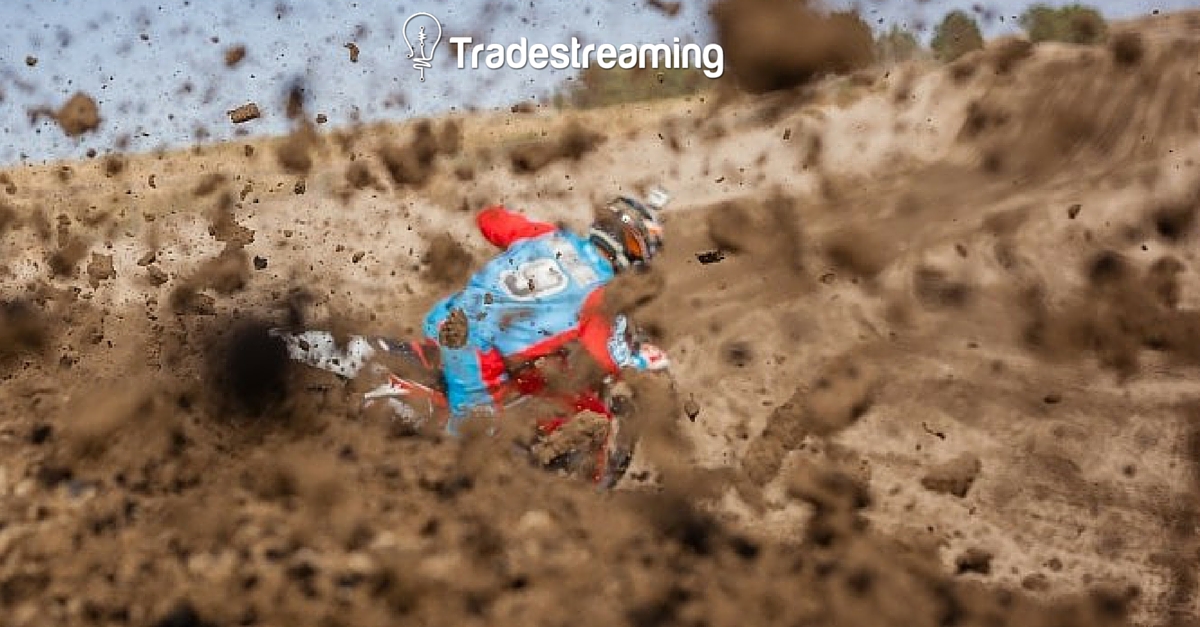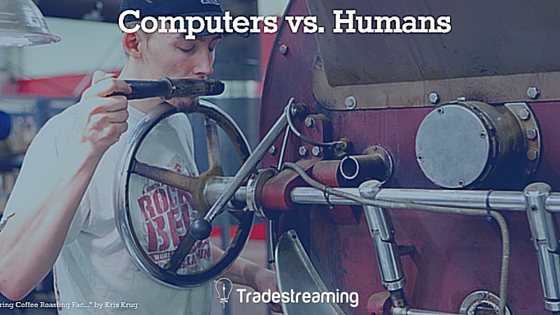5 trends we’re watching this week
Selling Data: The emerging role of finance’s Chief Revenue Officer
Computers vs. Humans: Who wins the investment game?
We’ve entered an era in investing where we read daily about billionaire stock pickers who’ve built large fortunes off their uncanny ability to invest in winners. There’s an entire cottage industry of websites that track all the investment moves of large fund managers in the hope for gleaning the next big homerun investment. Books like John Reese’s Guru Investor have deconstructed the strategies these top investors use so that investors at home can play along.
Here’s Estimize’s founder, Leigh Drogen on the humanness of great investing:
But here’s where it gets interesting. The best humans are still leaps and bounds better at investing than the best computers and the quantitative analysts behind their algorithms. Why? Because we’re just starting to scratch the surface of artificial intelligence in investing, and algorithms are still relatively dumb and inflexible. The best humans are still incredible at pattern matching and adjusting when correlations fall apart. Call it intuition, call it whatever you want, humans still have something extra that computers don’t (for now).
There is still something innately human about being able to identify and manage a great investment. No matter how good computers are at this point, they can’t recreate that special something.
On the other hand, much of today’s investing is happening via algorithms, via machines programmed to do what humans can’t — stick to an investment strategy. Trading volume in certain markets, like government bonds, is estimated to be 90% comprised of algorithms. That means buying and selling is happening machine-to-machine.
Machines can do something that behavioral finance experts know that humans just aren’t built to do: turn off their emotions and stick to a strategy. Algorithmic platforms enable quick filtering of investment candidates against standardized investment criteria and removes extraneous pressures and can make quantitative sense of conflicting signals.
So, which is it? Experts tend to say it’s a little bit of both. It’s the confluence of machines and humans that makes for the best, most successful investing. It’s the computer-enabled research and strategy building that enables a human, in spite of all his or her biases, to pull the trigger, when and where he or she determines is most appropriate.
According to Matthew Klein, the founder and CEO of Collective2, a platform for humans to devise, test, and manage algorithmic trading strategies, new investors should stick to the type of investing that plays to our strengths:
So if I were asked to give advice to some young hot-shot kid MBA at Harvard wondering what kind of investing field to pursue, I would say: Focus on the stuff that requires physical carbon. Do stuff that requires that you stand up at a podium and deliver a speech. Be a short-seller like Andrew Left who can scare the bejeesus out of investors by emailing a really cheesy PDF file to people in your rolodex.
To explore this concept further, Tradestreaming recently invited machine-human investing experts Matthew Klein, CEO of Collective2 and Leigh Drogen, CEO of Estimize to a frank conversation on the relative merits of algorithmic investing and stock picking.
View Can A Computer Do It Better? on Dealbreaker.
Top 12 Investing Tools of 2012
2012 was in many ways uneventful for those of us looking at the investing tools space.
Maybe it was general yawning at the stock market and less participation/caring about investing.
Or maybe it was because little capital flowed to new, innovative investment tools this year (a few existing companies like Betterment raised money).
That said, many of the existing investing tools in the marketplace are maturing. Products are getting easier to use and in general, gaining in popularity.
Here’s a group of 12 tools (you’re welcome to add more below) that I believe were worth your attention this past year (I’ve interviewed many of the founders of these companies on my podcast). They are a smattering of new tools (like SmartAsset) and older ones (Lending Club just celebrated its 5th year anniversary) that keep getting better with time.
Curious as to what you think — full disclosure: I was an early hire at Seeking Alpha and still own woefully too few shares and I’ve consulted to Wall Street Survivor and Lending Club.
Top 12 investing tools of 2012
(in no particular order)
- SmartAsset: So smartly designed and so necessary, it’s a shame SmartAsset didn’t launch years ago. It’s like a Web 2.0 financial calculator that provides personalized advice to help answer the most common of financial decisions like “should I rent or buy?“.
- QuantBlocks: QuantBlocks is a cool and powerful platform to help design and test quantitative trading strategies. The best part is that it doesn’t require any programming expertise. It’s just drag-and-drop simple.
- Seeking Alpha Pro: Recently launched, the price-point (around $200/mo) and the quality of the research on Seeking Alpha Pro makes it primarily for professional investors. Of higher quality than general posts on SA, Pro is intended to raise the bar of Seeking Alpha’s exclusive content and cement its role as the open destination to head online for stock research.
- Wall Street Survivor: Wall Street Survivor is the investor’s CodeAcademy. It’s designed for beginners and intermediate investors alike. WSS provides very specific, action-based missions for learning the ins-and-outs of investing.
- Motif Investing: Motif Investing is a platform for idea-driven investing. If you’re looking to create a low-cost portfolio of stocks around a specific idea, Motif is pretty interesting.
- SprinkleBit: SprinkeBit has bold goals and that’s to provide a one-stop-shop for younger investors. It combines the social sharing and learning with a brokerage platform.
- Reading the World: Russel Redenbaugh’s new newsletter is based upon decades of experience with policy-driven investing. It examines big macro trends and how government/economic policy impacts such movements.
- OurCrowd: There are a lot of crowdfunding platforms waiting for the JOBS Act to really hit but OurCrowd is already up and running and funding some top Israeli startups. For accredited investors only, investors can build a startup portfolio with increments as small as $10k.
- Lending Club: The peer lending network just celebrated its 5 year anniversary and $1B in assets. Together with smaller competitors, the peer lending industry is underwriting about $100M in loans every month now. LC Notes are becoming de rigeuer in diversified income portfolios (where else can you find high single digit, low double digit returns right now?).
- Estimize: Crowdsourcing really works and that’s true for earnings information. Estimize has shown that it’s frequently more accurate than Wall Street when it comes to financial estimates.
- StockRover: StockRover is a financial data portal that was built by a techie investor for others like him. If you enjoy deep diving into the data and doing great stock screens, StockRover is really powerful.
- Kivalia: Investors with assets in retirement accounts get the short end of the stick. They lack good advice. Kivalia is changing that with an advice layer on 401ks that tells investors what and when to buy — down to advice on which mutual funds they should own.
[listly id=”2hk” layout=”full”]
What tools/platforms did you enjoy this year? Let me know.
Dueling investing apps: How to best forecast earnings
In investing, earnings drive stock prices. The thing is, though, for many higher growth firms, it’s really hard to determine just how likely a firm is to hit its stated targets.
An earnings miss — or even a hint of one – can be disastrous to share prices.
So, investors spend a lot of time listening to this analyst and that pundit explain his expectations for earnings.
The truth is, very few of these guys get it right.
A better way to get earnings estimates: crowdsource ’em
Most of the time we use analyst consensus earnings — an average of all the different Wall Street opinions.
The problem with using an average is that earnings estimates on certain stocks diverge pretty significantly and taking the average isn’t an entirely accurate way of trying to gauge earnings.
There are a couple of ways to do this better/smarter right now.
Continue reading “Dueling investing apps: How to best forecast earnings”
Stock Twits, Estimize, and the future of social investing – with Leigh Drogen
Leigh Drogen played an integral role in StockTwits‘ success. Now, he’s on to his own startup, Estimize, which takes aim at improving financial estimates with a decidedly social approach.
Drogen shares his own experience and history as an investor and now entrepreneur as he’s one of the most vocal proponents of using a mix of social media communications to enhance the investing process.
He’ll share his vision of social investing and how Estimize should help investors become more accurate.
Continue reading “Stock Twits, Estimize, and the future of social investing – with Leigh Drogen”












